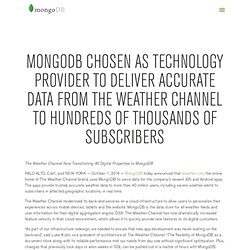

Hasan Tayyar Beşik
özetler iyidir :
Mongodb/mongo-tools. Chosen as Technology Provider to Deliver Accurate Data from The Weather Channel to Hundreds of Thousands of Subscribers. The Weather Channel Now Transitioning All Digital Properties to MongoDB PALO ALTO, Calif., and NEW YORK — October 1, 2014 — MongoDB today announced that weather.com, the online home of The Weather Channel brand, uses MongoDB to serve data for the company’s newest iOS and Android apps.

The apps provide trusted, accurate weather data to more than 40 million users, including severe weather alerts to subscribers in affected geographic locations, in real time. The Weather Channel modernized its back-end services on a cloud infrastructure to allow users to personalize their experiences across mobile devices, tablets and the website. MongoDB is the data store for all weather feeds and user information for their digital aggregation engine, DSX. The Weather Channel has now dramatically increased feature velocity in their cloud environment, which allows it to quickly provide new features to its digital customers.
“MongoDB has a level of maturity and feature set that competitive offerings lack. At Mailbox. Strategies for Reducing Wasted Space in MongoDB ObjectRocket Blog. Appboy is the world’s leading marketing automation platform for mobile apps.

We collect billions of data points each month by tracking what users are doing in our customers’ mobile apps and allowing them to target users for emails, push notifications and in-app messages based on their behavior or demographics. MongoDB powers most of our database stack, and we host dozens of shards across multiple clusters at ObjectRocket. One common performance optimization strategy with MongoDB is to use short field names in documents. That is, instead of creating a document that looks like this: In addition to collecting event data, Appboy also lets our customers store what we call “custom attributes” on each of their users. To solve this, we tokenize the custom attribute field names using what we call a “name store.” The name store document schema is extremely basic: there is one document for each customer, and each document only has one array field named “list.”
Checking if a document exists - MongoDB slow findOne vs find. Hayat Ağacı ~ The Tree Of Life ~ (2010_2011) Khalkida davası. YSlow for Command Line. Twitter: Yours to discover. Using A Graph Database To Power The “Web of Things” Counting Unique Items with Map-Reduce. Credit: Kyle Banker Problem You have a collection that stores pageviews by user, and you want to count the total number of unique user visits per day using map-reduce.

Each pageview document looks something like this: The solution requires grouping the pageviews by day and then counting the total number of user visits and along with the number of unique visits for that day. Solution What's tricky about this situation is that it requires a two-pass map-reduce in order to scale well. 1. Map Step The only tricky part about the map function is making sure that we emit on the day. If you want a more efficient date calculation, you can use this: day = (24 * 60 * 60) % this.date; Reduce Step The reduce function is trivial, as it simply performs a count: Run the command We run the mapReduce command, storing the output in the pageview_results collection: 2. Now that we have a prelimiary set of results, we can do a second pass to count unique users by day. Running the command That's all there is to it! 5. How does foursquare generate their user IDs. Tayyar amaçsızca açtı bu blogu.
Kahrolsun Stalinistler!